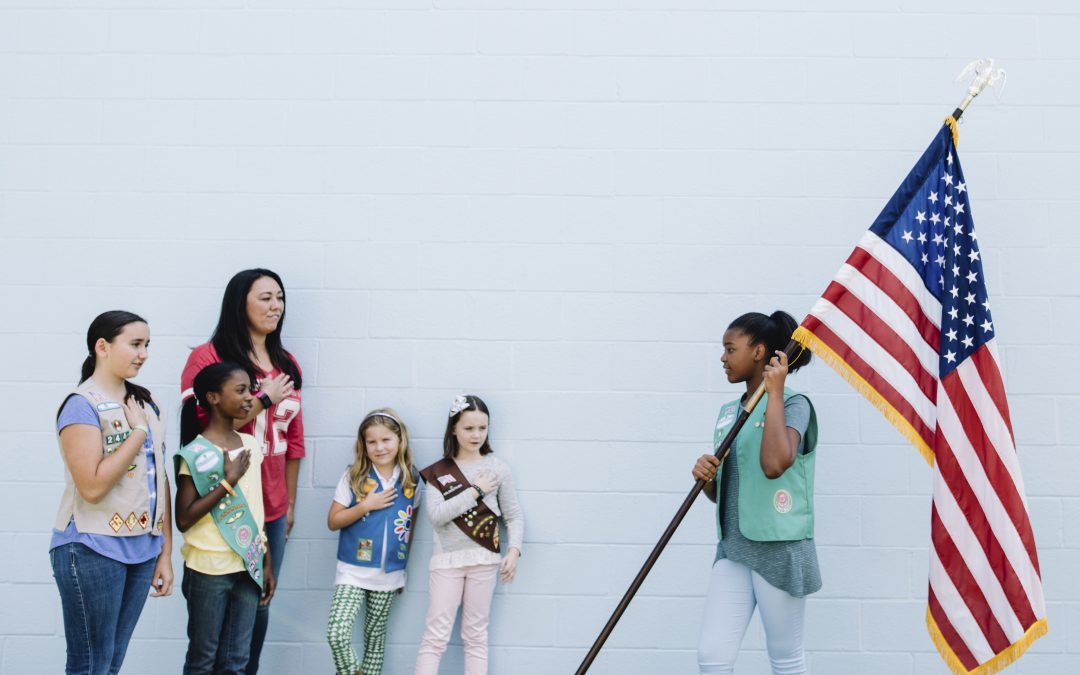Stars and Stripes, the Star Spangled Banner, Old Glory—whatever you call it, the American flag is an important symbol to Girl Scouts in the United States. If you have been to a Girl Scout event, chances are you’ve seen or participated in a flag ceremony. Flag ceremonies are the perfect way to start and end a whole host of activities, from holidays like Memorial Day and Independence Day to Court of Awards, bridging ceremonies, camp events, or even service unit meetings, and you can host them anywhere: meeting rooms, outdoor settings, large auditoriums, on stage—even on horseback!
Pin this post for later!
There’s no perfect recipe for a flag ceremony but the one thing they all have in common is respect for the flag. From planning a flag ceremony to ceremony terms, flag rules, and ceremony commands, here’s what you need to know:
Flag Ceremony Terms to Know
- Color Bearer: The color bearer is the person who carries the flag and places it on the pole or in the stand. There is one color bearer for each flag used in the ceremony. The color bearer should hold the staff (pole) at 30° angle in front of body, or hold folded flag (with point away from body) in front of body at waist level.
- Color Guard: The color guard is a team that guards and protects the flags. Any even number of guards may be used, but usually four or six girls are sufficient. Because this requires full attention, the members do not participate in any part of the flag ceremony (singing, speaking, etc.), but stand silently “At Attention”
- Caller: The caller is a designated Girl Scout who announces or calls each command or part of the ceremony.
- Line Leader: Usually part of an outdoor color guard, the line leader will lead the audience into/out of the desired formation (usually a horseshoe shape in Girl Scouts).
Planning Your Flag Ceremony
As you start planning for your ceremony, the best thing you can do is keep it simple. Emphasis needs to be on respect for the flag rather than on the commands or techniques. As your girls start to brainstorm, you can use these guiding questions to help them plan a complete ceremony:
- What is the tone we’re trying to set?
- Who will carry the flag(s)?
- Who will be the color guards?
- Who will give the directions for the ceremony?
- What song will be sung? Who will lead it?
- Will a poem or quotation be included? Who will say or read it?
- After the Pledge of Allegiance, will the Girl Scout Promise and the Law be said?
- In what order will the parts of the ceremony take place?
- When will the group practice?
- Where will the flags be placed at the end of the ceremony?
You could go with something very simple like this troop, just marching the colors in and proceeding with your event (video starts at 3:32). You could add in elements like a salute, singing a different song, and silent color guards who focus on the flags instead of participating in the pledge or anthem like Troop 105 (ceremony starts at 6:26). Or you could go all out like the Girl Scout Greater Los Angeles Color Guard did for this meeting of the American Legion.
Proper American Flag Rules and Protocol
Display of the American flag is governed by law to ensure that it will be treated with the respect due the official flag of a nation. This is known as the United States Flag Code. Some of the rules most useful for Girl Scouts are:
- The flag must only be displayed from sunrise to sunset, unless it is illuminated.
- The American flag must be placed in the center, and higher, when displayed with a group of state, local, or organizational flags flown from staffs. It may also be positioned to the right of other flags. (If girls were to hold the flag while facing their audience, their right side would be the flag’s own right.)
- When displayed from a staff in a public auditorium, the flag of the United States must hold the position of superior prominence, in advance of the audience, and in the position of honor at the speaker’s right as they face the audience. Any other flag should be placed to the left of the speaker.
- The flag is to be hoisted briskly and lowered slowly with dignity.
- Take every precaution to prevent the Flag from becoming soiled. It should not be allowed to touch the ground, nor to brush against objects.
- The flag, when carried in a procession with other flags, should be either on the marching right or, if there is a line of other flags, in front of the center of that line.
Bonus Info: Flag Retirement Ceremony
When the U.S. Flag becomes tattered or worn, it should be disposed of by burning. Your local American Legion or Veterans of Foreign Wars can teach your girls the proper protocol or help perform the flag ceremony if you like.
This is a very solemn ceremony and should be done with the utmost respect and reverence for the flag to be retired. Explain this ceremony and its purpose thoroughly to the girls so that they don’t go home and tell their parents that they “burned a flag at Girl Scouts!”
Flag Ceremony Commands
A part of the flag ceremony is precision and formality, and the traditional commands are part of that. Use whichever commands are relevant to your own flag ceremony, and feel free to mix them up as needed. Here are a possible opening and closing set of commands. These are both using as many commands as possible to show you your options, but there’s no right order, or minimum amount of commands required.
Opening:
- “Girl Scouts, Attention.”
- Girl Scouts stand quietly and remove all headwear; this is a signal the ceremony is about to start.
- “Color guard, Attention.”
- If the color guard is standing “at ease,” it comes to “attention.”
- “Color guard, Advance.”
- Color guard carries the flag(s) towards flag pole or stand.
- “Color guard, post the colors.”
- Color guard places the flag in its stand, or unfolds and hoists the flags up the poles in the appropriate order (The American flag always comes first, and the state flag if you have it is usually next, with any flags after that going in order of importance.)
- “Color guard, salute the colors.”
- Color guard salutes the flag and then returns to “attention.”
- “Girl Scouts, honor your colors.”
- Girl Scouts salute the flag.
- “We will now say the Pledge of Allegiance.”
- If you have a color guard, they should stand at attention and not participate, keeping their full attention on the flag.
- “We will now sing the National Anthem.”
- Similarly, the color guard, if you have one, should stay focused on the flag. Feel free to also pick a different patriotic song.
- “We will now say the Girl Scout Promise.”
- Similarly, the color guard, if you have one, should stay focused on the flag.
- “Color guard dismissed.”
- Color guard retreats to the back of the room but stays standing at attention.
- “Girl Scouts dismissed.”
Closing:
- “Girl Scouts, Attention.”
- Girl Scouts stand quietly and remove all headwear; this is a signal the ceremony is about to start.
- “Color guard, Attention.”
- If the color guard is standing “at ease,” it comes to “attention.”
- “Color guard, Advance.”
- Color guard approaches the posted flags.
- “We will now sing (insert appropriate song here, “Taps” or other relevant songs.)”
- Color guard remains at attention and does not take place in any singing or speaking.
- “Color guard honor your colors.”
- Color guard salutes the flag and returns to attention.
- “Color guard, retire the colors.”
- Flag is slowly lowered and folded; American flag first, and then in reverse order that they went up.
- “Color guard, dismissed.”
- Color guard carries the flag to an appropriate place at the back of the room.
- “Girl Scouts dismissed.”
Whether you’re adding some pomp and circumstance to your Court of Awards ceremony or celebrating the Fourth of July in style with your troop, a flag ceremony is a special Girl Scout skill, and an honor. You can even earn a patch for it! So what are you waiting for: get practicing!
What to do next:
- Looking for a related read? Check out Girl Scouts River Valleys’ Flag Ceremonies 101 post.
- For more information, visit the Flag Ceremony page on GSUSA’s website.
- Review the videos in the Planning Your Flag Ceremony section, and start planning your next flag ceremony.

Marissa Vessels—Marissa is the Director of Marketing at Girl Scout of Northern California and a Gold Award Girl Scout. Though she’s originally from Southern California (Yay, Girl Scouts of San Gorgonio Council!), she moved to the East Bay to attend UC Berkeley and never looked back. One of her favorite things about Girl Scouting in the Bay Area is all the incredible hiking and camping options available to girls who love to explore the great outdoors.

